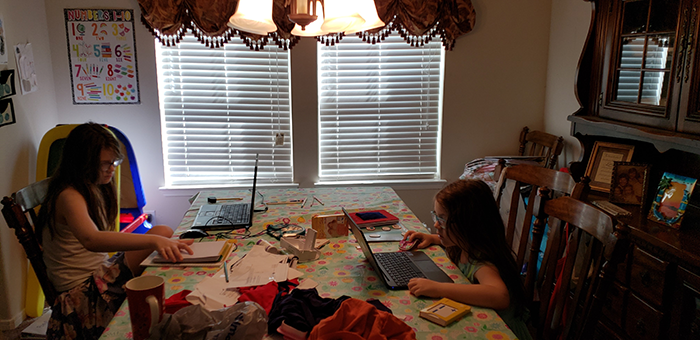This blog post was planned about a month ago, but as with everything, life happens. This brings me to the biggest benefit for homeschooling for our family — the flexibility of life. When asked why I homeschool, my answer is typically longer than necessary, but it comes down to finding balance.
I’m Julie, mom of Mikaela, Hannah and Hope, and wife to Jeremy. My eldest daughter, Mikaela, is 23 and lives in Colorado where she is studying to be an EMT. I homeschool Hannah and Hope who are 12 and 7. Just to throw a bit more uniqueness into the mix, my husband is a public school band director. That’s right, we homeschool our girls and my husband teaches public school in one of the best districts in our state.
Clearly, our homeschool journey isn’t one that started with an aversion to public school. My husband and I both went to public school and had relatively positive experiences. We each have our own brief high school horror story, but nothing too traumatic. Our eldest daughter, Mikaela, went to private school for K-4 and public school for the remaining years. She even graduated a year early from a local public charter high school where she was also able to attend college classes.
“When schoolwork would be sent home, I would search the same topic in Time4Learning. We would do that lesson together, and then Hannah would do her work from school. This helped boost her confidence immensely. It also helped my confidence to realize I had all the tools I needed to teach my girls full–time.”
Julie K.
So, how did we get to full-time homeschooling when we seemingly had zero issues with public school and, in fact, our family wouldn’t survive without public schools? Initially, I didn’t consider homeschooling. When the kindergarten round-up took place at our local elementary school, when Hannah was about to start kindergarten, I happily went. I sat and listened to the principal repeatedly boast about how well the school did on STAAR testing (our state’s standardized test.) She emphasized that they start preparing kids for STAAR as early as kindergarten. The emphasis on standardized testing overwhelmed me. In my gut, I felt there had to be a better way to ensure that my daughter was receiving a good education that wasn’t dependent on bubbling in little circles.
 I began researching homeschooling, but since my husband is a public school teacher, he had clear preconceptions of what school should be and what it should look like. Our compromise was a local private school that offered a university-model, or homeschool hybrid environment. Hannah went to school Tuesdays, Wednesdays and Thursdays, and on Monday and Friday, we worked on curriculum packets that the school provided. It was the perfect introduction to teaching my daughter at home. It balanced my desire to have more input on Hannah’s education, while offering my husband the assurance of a brick and mortar school.
I began researching homeschooling, but since my husband is a public school teacher, he had clear preconceptions of what school should be and what it should look like. Our compromise was a local private school that offered a university-model, or homeschool hybrid environment. Hannah went to school Tuesdays, Wednesdays and Thursdays, and on Monday and Friday, we worked on curriculum packets that the school provided. It was the perfect introduction to teaching my daughter at home. It balanced my desire to have more input on Hannah’s education, while offering my husband the assurance of a brick and mortar school.
As Hope got older, we discussed whether we would put both girls in the hybrid school, or simply homeschool them both. When Hannah was in the 4th grade, I began researching homeschool curriculum and stumbled upon Time4Learning. It seemed like the perfect set up to help me with teaching Hannah, and to have some reinforcement in areas I am weak in. While still attending hybrid school, Hannah used Time4Learning to supplement her school work. Hannah has always struggled in math, so that was the primary method we used to strengthen her skills. When schoolwork would be sent home, I would search the same topic in Time4Learning. We would do that lesson together, and then Hannah would do her work from school. This helped boost her confidence immensely. It also helped my confidence to realize I had all the tools I needed to teach my girls full–time.
Time4Learning also adjusted my husband’s misconceptions of what learning should look like. He realized that school could be done efficiently and with the ability to still foster learning without constricting timelines and set schedules. Again, we found our center and balance!
One of the most common questions I get from friends and people interested in homeschooling, is how I manage to teach my girls who are in such drastically different levels academically (this year Hannah is doing 7th grade work and Hope 1st). We try to do as much together as possible, but have enough independent work to balance.
For our family, we do our electives (music, art, and foreign language) together, as well as some social studies. Being that Hannah is so much older, Hope isn’t going to be on the same level as her in some areas, but it’s fairly easy to adapt. For example, Hannah primarily uses Time4Learning for her core classes, including ancient world history. Hope, typically, wouldn’t have a history class in 1st grade, but for her social studies work, part of Hannah’s grade is to “teach” Hope what she learned in her class before taking her quiz. This helps two-fold. First, Hope learns about things that aren’t typically offered to 1st graders, and secondly, it helps Hannah study. I also take this approach with science.
Electives are the easiest way to eliminate the juggling of teaching. For the most part, no matter the age and skill difference, all children can learn art and music together and sometimes foreign languages. The other key to teaching kids of different ages and learning levels is a balance of independent work.

Time4Learning is the program that works for us when it comes to independent learning. For Hannah, Time4Learning is her core curriculum. It provides all of her main subjects, and with language arts extensions, she gets her writing supplemented as well. For Hope, we use Time4Learning to reinforce the offline, text-based curriculum I use. Using it to supplement her existing curriculum builds her confidence immensely. I never have her do a lesson on Time4Learning that she hasn’t learned in her other work. This way, when she goes on Time4Learning she has that “I got this” attitude of knowing she can do the work without much help from me. As a 7-year-old, her independent focus is still a little hard for her, so having a computer-based program for her to do on days or at times when I need to focus on something else, is invaluable.
The set-up of Time4Learning is ideal for creating independent learners, especially as they get older. I set up a weekly planner for Hannah and she loves having the ability to simply turn on her computer and knowing exactly what is expected for the day and week. She has begun planning out her week according to what she is expected to do. As someone who has taken online college courses, I know that giving her this independence will lead to greater success once she reaches college. For Hope, I allow her to simply go in order of the activities. This removes the pressure of “having to finish” on a certain timeline and, instead, simply fosters the desire to learn.
As I mentioned at the beginning of this post, flexibility has been the greatest benefit I have discovered in homeschool. We are in the process of moving, and all the while my girls have continued to learn without being interrupted by our life changes. I have been homeschooling my girls in some way or another for more than 7 years and I wouldn’t trade the experience for anything. Being such an integral part of my girls’ growth in their education has brought me a joy that I never imagined. Finding the balance between helping each girl has kept me sane and made their experiences better.
About the Author
Julie K. is a Time4Learning member from Texas. She is a wife, homeschool mom to 3 children, and a full-time student herself.







